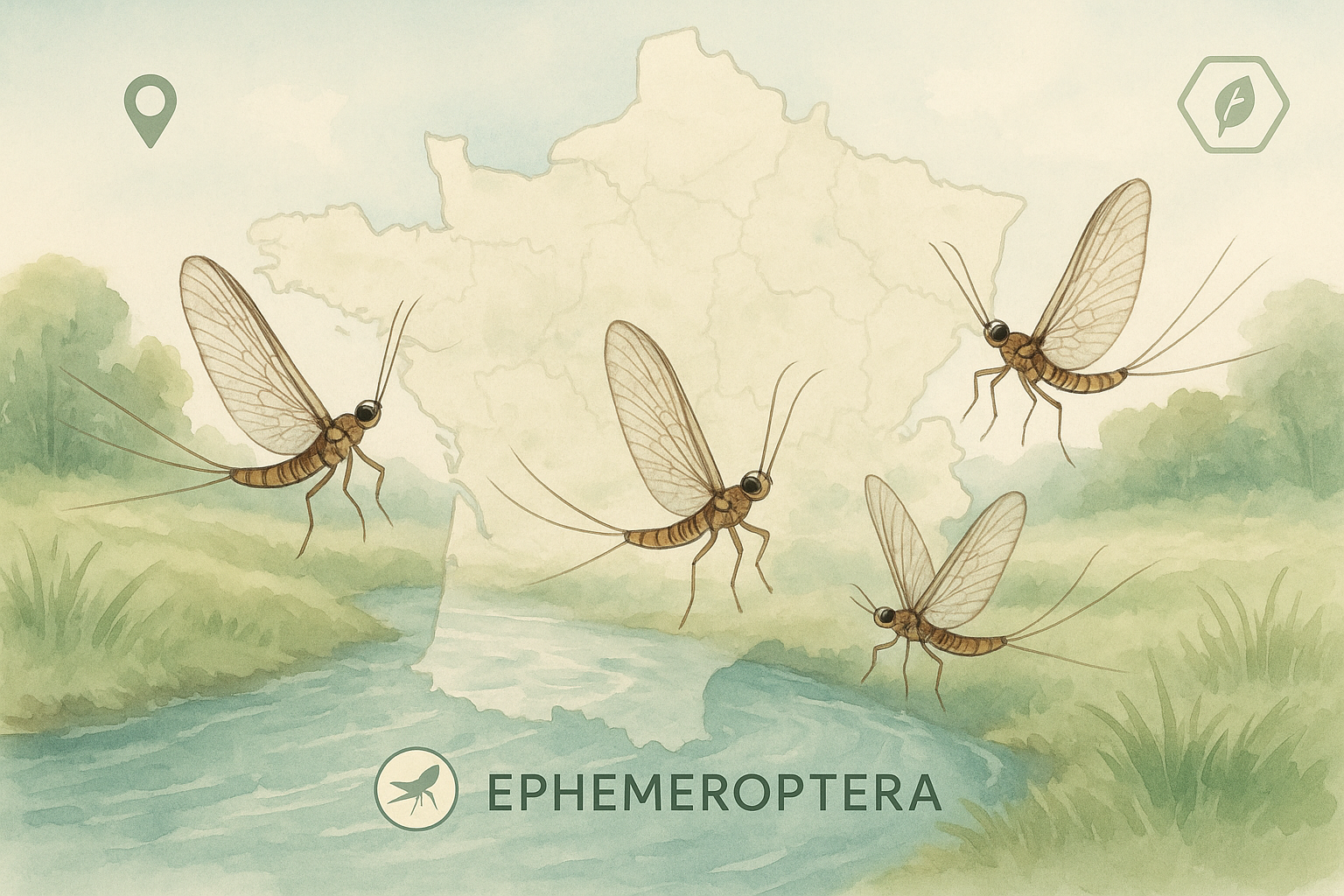
A visual tribute to French mayflies and biodiversity mapping
Overview
Éphémères de France is the official French national inventory dedicated to mayflies (Order: Ephemeroptera). Initiated in the mid-1990s by entomologists Michel Brulin and Gérard Masselot, the project set out to document all mayfly species across metropolitan France. It forms part of the national biodiversity inventory programs coordinated by the Muséum national d’Histoire naturelle (MNHN), in collaboration with OPIE-Benthos (Office for Insects and their Environment) and other aquatic entomology organizations. A scientific committee—chaired by Dr. Alain Thomas and Dr. André Nel—ensures the integrity of taxonomic standards and research methodology.
Since its official start in 1996, Éphémères de France has mobilized a vast network of volunteer contributors and researchers throughout the country. These participants collect ecological data from both larval and adult mayflies in rivers, lakes, streams, and ponds. More than 190 volunteers took part in the early data collection phases. As of 2006, the program had documented 129 species across 38 genera and 14 families—among them, 2 species new to science and 14 species never before recorded in France. Remarkably, species once believed extinct within French borders have been rediscovered. This effort has produced a detailed national checklist, establishing a solid foundation for ongoing ecological monitoring and conservation planning.
Scientific Goals
The Éphémères de France inventory was created with several key scientific objectives:
- Mapping Species Distribution: Systematically document the geographic distribution of all known mayfly species throughout metropolitan France by compiling occurrence records across every département, including Corsica.
- Taxonomic Clarification: Provide accurate and updated information on the statut taxinomique (taxonomic status) of each recorded species. Some genera—especially within Baetidae and Heptageniidae—require revision, and the inventory plays a vital role in identifying these gaps for further taxonomic research.
- Discovery of New Species: Detect and validate species new to science or previously undocumented within the French territory. Field sampling has already yielded significant first-time discoveries.
- Conservation Assessment: Collect the necessary data to assess the conservation status of mayfly populations, supporting the development of regional and national Red Lists for Ephemeroptera.
- Knowledge Dissemination: Publish distribution atlases, checklists, and peer-reviewed findings. The first two volumes of a national atlas have been released, with ongoing reports featured in the journal Ephemera and the OPIE-Benthos bulletins.
Statut taxinomique
The statut taxinomique of a species refers to its validated taxonomic classification. One of the primary goals of Éphémères de France is to maintain and refine the taxonomy of mayflies in France. Ephemeroptera systematics remains a dynamic and complex field—studies from the late 20th century revealed multiple cryptic species and taxonomic inconsistencies, especially in families like Heptageniidae. Some broadly defined species were later understood to be species complexes requiring revision.
As part of this initiative, every reported species undergoes expert review to confirm its identity. Where taxonomic ambiguities exist—such as unresolved lineages within Baetidae or Heptageniidae—the inventory flags them for targeted investigation. This vigilance ensures that the national species checklist remains up to date, scientifically accurate, and aligned with global taxonomic standards.
Species Distribution in France
A key strength of the Éphémères de France inventory lies in its detailed documentation of mayfly distribution across the country. Data gathered from over 3,000 sampling sites have been analyzed to produce accurate maps showing where each species has been observed. The inventory compiles présence par département lists—comprehensive breakdowns of species recorded in each of France’s administrative regions, including Corsica.
These lists and maps allow users to easily assess the known geographic range of any given species, highlighting both well-studied regions and areas requiring further sampling. Such resources are invaluable for biogeographical research and for environmental monitoring agencies seeking to track shifts in species distributions over time.
Historically, the inventory’s website offered public access to this data in an intuitive interface. Visitors could search by département to view all reported species or select a specific species to see its full distribution across France. The national scope and granularity of this information make it a vital reference tool for scientists, naturalists, and conservation professionals.
🔍 Interested in the broader mission? Visit our homepage for more information on related environmental knowledge and archived projects.
Bibliography and Key Publications
The Éphémères de France inventory also serves as an enduring archive of scientific knowledge. Over the years, it has produced a number of foundational works that have shaped the study of Ephemeroptera in France:
- Thomas & Masselot (1996): Les Éphémères de France : inventaire des espèces signalées et des espèces potentielles — The initial catalog of recorded and potential species by département, which established the foundation for the national inventory.
- Brulin (2007): Atlas de distribution des Éphémères de France, 1ère partie — The first volume of the national mayfly atlas, covering most families except Baetidae and Heptageniidae, and presenting detailed species maps and ecological notes.
- Brulin (2009): Atlas de distribution des Éphémères de France, 2e partie — The second volume completing national coverage, with a focus on Baetidae and Heptageniidae, published in the scientific journal Ephemera.
- OPIE-Benthos Bulletins (1996–present): Ongoing contributions published in the Benthos newsletter and Ephemera, reporting newly observed species, taxonomic clarifications, and inventory progress.
For additional authoritative information on France’s national biodiversity inventories, visit the Inventaire National du Patrimoine Naturel (INPN).
Together, these publications provide an essential knowledge base for mayfly researchers, aquatic ecologists, and conservation practitioners. With its blend of rigorous taxonomy, field data, and long-term monitoring, the Éphémères de France archive continues to support biodiversity science across Europe.
Learn more or get involved: visit the Éphémères de France homepage for current information and updates.